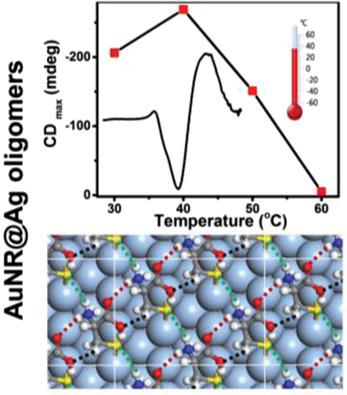当前位置:
X-MOL 学术
›
Adv. Opt. Mater.
›
论文详情
Our official English website, www.x-mol.net, welcomes your
feedback! (Note: you will need to create a separate account there.)
Temperature Effect of Plasmonic Circular Dichroism in Dynamic Oligomers of AuNR@Ag Nanorods Driven by Cysteine: The Role of Surface Atom Migration
Advanced Optical Materials ( IF 8.0 ) Pub Date : 2020-11-13 , DOI: 10.1002/adom.202001274 Dejing Meng 1, 2 , Yuandong Chen 1 , Yinglu Ji 1 , Xinghua Shi 2, 3 , Hui Wang 2, 3 , Xiaochun Wu 1, 2
Advanced Optical Materials ( IF 8.0 ) Pub Date : 2020-11-13 , DOI: 10.1002/adom.202001274 Dejing Meng 1, 2 , Yuandong Chen 1 , Yinglu Ji 1 , Xinghua Shi 2, 3 , Hui Wang 2, 3 , Xiaochun Wu 1, 2
Affiliation

|
Achieving huge chiroptical responses is one of the driving forces for the applications of plasmonic metamaterials. Heat‐assisted symmetry breaking can amplify plasmonic circular dichroism (PCD) signals in Au nanorod (AuNR) oligomers; however, the PCD responses disappear on Ag‐exposed surface (AuNR@Ag core‐shell nanorods) at high temperature. Thus, the inherent reason of different chiral response between Au‐ and Ag‐surface nanorods oligomers is explored, and the chiral mechanism is further cognized. The enhanced mobility of surface Ag atoms at elevated temperatures leads to the damage of cysteine chiral networks on Ag surface. It therefore causes great reduction of chiral drive forces, thus restricting the PCD temperature amplification effect to a lower annealing temperature, compared to their Au‐exposed counterparts. In addition, the PCD signals of the AuNR@Ag oligomers show a pH‐dependent on‐off behavior, substantiating the dominant role of chiral network. In addition, density functional theory simulation and relevant experiments reveal facet‐dependent chiral response of Ag and Au oligomers. Then, Au–Ag alloy shells can suppress Ag atoms migration; the chiral network and PCD temperature amplification effect can exist in high temperature. The findings reveal the importance of understanding interface ligands, plasmonic nanoparticles, and their interactions in the rational design of chiral assemblies composed of plasmonic nano‐units.
中文翻译:

半胱氨酸驱动的AuNR @ Ag纳米棒动态低聚物中等离子圆二向色性的温度效应:表面原子迁移的作用
实现巨大的按摩反应是等离子超材料应用的驱动力之一。热辅助对称断裂可放大金纳米棒(AuNR)低聚物中的等离激元圆二色性(PCD)信号;然而,在高温下,PCD响应在暴露于Ag的表面(AuNR @ Ag核壳纳米棒)上消失了。因此,探索了金和银表面纳米棒低聚物之间手性响应不同的内在原因,并进一步认识了手性机理。在升高的温度下表面Ag原子迁移率的提高导致Ag表面上半胱氨酸手性网络的破坏。因此,与手性暴露于金的对应物相比,它会大大降低手性驱动力,从而将PCD温度放大效应限制在较低的退火温度。此外,AuNR @ Ag低聚物的PCD信号表现出pH依赖性的开-关行为,证实了手性网络的主导作用。此外,密度泛函理论模拟和相关实验揭示了Ag和Au低聚物的面依赖性手性响应。然后,Au-Ag合金壳可以抑制Ag原子的迁移。手性网络和PCD的温度放大作用可以在高温下存在。这些发现揭示了在合理设计由等离激元纳米单元组成的手性组装体时,了解界面配体,等离激元纳米颗粒及其相互作用的重要性。密度泛函理论模拟和相关实验揭示了Ag和Au低聚物的多面性手性响应。然后,Au-Ag合金壳可以抑制Ag原子的迁移。手性网络和PCD的温度放大作用可以在高温下存在。这些发现揭示了在合理设计由等离激元纳米单元组成的手性组装体时,了解界面配体,等离激元纳米颗粒及其相互作用的重要性。密度泛函理论模拟和相关实验揭示了Ag和Au低聚物的刻面依赖性手性响应。然后,Au-Ag合金壳可以抑制Ag原子的迁移。手性网络和PCD温度放大效应可以在高温下存在。这些发现揭示了在合理设计由等离激元纳米单元组成的手性组装体时,了解界面配体,等离激元纳米颗粒及其相互作用的重要性。
更新日期:2021-01-18
中文翻译:

半胱氨酸驱动的AuNR @ Ag纳米棒动态低聚物中等离子圆二向色性的温度效应:表面原子迁移的作用
实现巨大的按摩反应是等离子超材料应用的驱动力之一。热辅助对称断裂可放大金纳米棒(AuNR)低聚物中的等离激元圆二色性(PCD)信号;然而,在高温下,PCD响应在暴露于Ag的表面(AuNR @ Ag核壳纳米棒)上消失了。因此,探索了金和银表面纳米棒低聚物之间手性响应不同的内在原因,并进一步认识了手性机理。在升高的温度下表面Ag原子迁移率的提高导致Ag表面上半胱氨酸手性网络的破坏。因此,与手性暴露于金的对应物相比,它会大大降低手性驱动力,从而将PCD温度放大效应限制在较低的退火温度。此外,AuNR @ Ag低聚物的PCD信号表现出pH依赖性的开-关行为,证实了手性网络的主导作用。此外,密度泛函理论模拟和相关实验揭示了Ag和Au低聚物的面依赖性手性响应。然后,Au-Ag合金壳可以抑制Ag原子的迁移。手性网络和PCD的温度放大作用可以在高温下存在。这些发现揭示了在合理设计由等离激元纳米单元组成的手性组装体时,了解界面配体,等离激元纳米颗粒及其相互作用的重要性。密度泛函理论模拟和相关实验揭示了Ag和Au低聚物的多面性手性响应。然后,Au-Ag合金壳可以抑制Ag原子的迁移。手性网络和PCD的温度放大作用可以在高温下存在。这些发现揭示了在合理设计由等离激元纳米单元组成的手性组装体时,了解界面配体,等离激元纳米颗粒及其相互作用的重要性。密度泛函理论模拟和相关实验揭示了Ag和Au低聚物的刻面依赖性手性响应。然后,Au-Ag合金壳可以抑制Ag原子的迁移。手性网络和PCD温度放大效应可以在高温下存在。这些发现揭示了在合理设计由等离激元纳米单元组成的手性组装体时,了解界面配体,等离激元纳米颗粒及其相互作用的重要性。











































 京公网安备 11010802027423号
京公网安备 11010802027423号